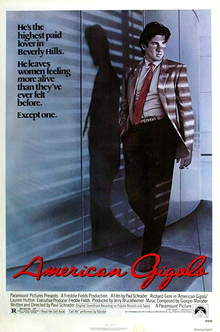Paul Schrader’s romantic melodrama, American Gigolo, is stylishly elegant, but emotionally hollow, all attributes that also describe the protagonist at its center, a cold but stylish $1000-a-night Los Angeles call boy whose physical appearance means everything to him–and to older women.
Grade: B (***1/2* out of *****)
| American Gigolo | |
|---|---|

Theatrical release poster
|
|
At the prime of his popularity, right after “Days of Heaven,” Richard Gere plays Julian Kay, a high-living, immoral hustler who cherishes his glitzy lifestyle, fashionable clothes, Mercedes car, and success, based on the fact that he caters to rich and famous clients, mostly older female of Beverly Hills.
Doing a favor for his former pimp (Bill Duke), Julian’s trick turns up dead a few hours later, but his actual client won’t give him an alibi. Needless to say, the police detective Sunday (Hector Elizondo) assigned to the case doesn’t believe in the gigolo’s innocence.
A frustrated politician’s wife, Michelle (model Lauren Hutton), with whom he sleeps for no fee, is willing to help if Julian could let down his defenses and accept her love.
Too bad that the tale gets increasingly improbable and that the ending is fake, a result of Schrader’s bad instincts as a writer, his insistence on including notions of true love and moral redemption. But the first half of the picture, in which we see Julian (and Gere) as a smug and narcissistic fellow, who enjoys what he does because he is good at it.
Visually, Schrader opts for a glitzy, sleazy movie, which combines elements of European art film with a voyeuristic, borderline exploitational view of the seamier side of sex and affluence in contempo Los Angeles.
A zeitgeist movie, American Gigolo captures the decadence, the sex-drug-music subculture of L.A. circa 1980.
As played by Richard Gere, in a role initially intended for John Travolta, Julian comes across as an inscrutable, emotionally detached, but not nasty or bad-hearted fellow, who seeks above all pleasure.
Sporting Giorgio Armani’s glorious clothes (stunning shorts, ties, jackets), and moving around sets created by Ferdinando Scarfiotti’s meticulous production design, Gere looks sexy, seductive, and appealing.
Contrary to expectations, the movie was a moderate success at the box-office, and much more popular than most of Schrader’s films before and after.
The film offers some superficial visual pleasures, such as the image of Gere’s cruising down the Pacific Coast Highway in his Mercedes convertible to the melodic score of Giorgio Moroder and of Blondie’s song “Call Me,” which became a hit, independently of the picture.
Ultimately, American Gigolo was more effective in bolstering Giorgio Armani’s name in America than in promoting Schrader or Gere’s careers. Schrader must have anticipated that, as he devotes a whole scene depicting a closet full of shelves of Armani suits, shirts and pants.
The movie was a box-office hit–it’s Schrader’s most commercial film to date–earning over $50 million against a modest budget of $5 million.
The film’s musical score was composed by Giorgio Moroder. The film’s main theme song, “Call Me,” performed by Blondie, was written by Moroder and Blondie vocalist Debbie Harry, and became a huge worldwide success in 1980.
It peaked at number one in the US and the UK, and became the highest-selling single of 1980 in the US. In 1981, the song was also nominated for a Grammy Award for Best Rock Performance by a Duo or Group with Vocal.
Cast
Richard Gere as Julian Kay
Lauren Hutton as Michelle Stratton
Bill Duke as Leon James
Héctor Elizondo as Detective Joe Sunday
Frances Bergen as Mrs. Laudner
Carol Bruce as Mrs. Sloan
K Callan as Lisa Williams
Carole Cook as Mrs. Dobrun
David Cryer as Lieutenant Curtis
Credits:
Directed, written by Paul Schrader
Produced by Jerry Bruckheimer
Cinematography John Bailey
Edited by Richard Halsey
Music by Giorgio Moroder and Blondie
Production and distribution: Paramount Pictures
Release date: February 1, 1980
Running time: 117 minutes
Budget $5 million
Box office $52.7 million










